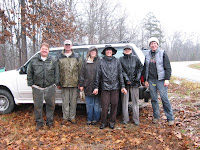I have met homeowners who would not consider anything but evergreens in their front yard. What a shame, because the winter landscape can be so beautiful and so dramatically different. A landscape should celebrate the seasons. Blooms, berries, sculptural forms, increased visibility and attractive foliage all add to the character of a changing landscape.
Evergreens can form a strong backbone for our plantings and should be used in a landscape, but not exclusively. Dwarf conifers and ornamental grasses can add height and form to a perennial border, balancing the profusion of color spring through fall. In winter, when the perennials are subordinate, the shape of the conifer, the sound and movement of the dry grasses and the dramatic forms of seedheads become the focus.
Two of my favorite plants to enhance the winter landscape are daffodils and Lenten roses. Both are easy to grow, long-lived, deer resistant, and bloom when we so desperately need flowers in our life.
Winter is when groundcovers, subordinate to showier blooming plants, often get noticed. Evergreen groundcovers contrast with bare trees, brown lawns, and fallen leaves. The bold foliage of cast iron plant and holly fern, the delicate texture of autumn fern, the expanse of liriope or mondo grass, the color of ajuga foliage - all more noticeable in winter.
Trees and shrubs provide winter interest in many forms: foliage, structure, blooms, and bark. The dogwood is a classic example of a combination of all four. The horizontal branching, flower buds, rugged bark, red berries and early spring blooms make this an all season (albeit fussy) plant. Leatherleaf mahonia has bold evergreen foliage, fall color, yellow spring blooms and blue summer berries. Many of the best winter plants offer much in other seasons as well.
Other trees and shrubs with interesting winter structure include the weeping yaupon holly, the wonderful variety of dwarf conifers and the pieris. Foliage interest is added with the bold mahonia and magnolia, or the colorful aucuba and loropetalum,
Trees and shrubs with a show of berries include several hollies, pyracantha, cotoneaster and burning bush. Interesting bark can be found on river birch and oakleaf hydrangea (exfoliating), crape myrtle (mottled, smooth), burning bush (winged), kerria, coral bark maple and red twig dogwood (colorful) and corkscrew willow and Harry Lauder’s walking stick (contorted). Branches of these plants are fun to bring into the house for winter arrangements.
Many trees and shrubs have winter and early spring blooms, including camellias, quince, sweet olive, deciduous magnolias (which also have fat, fuzzy buds), winter daphne, winter jasmine, witch hazel and forsythia.
Ornamental grasses are at their peak in winter, with graceful forms topped by plumes ranging from airy to massive. Enjoy these all winter, then cut them back when the daffodils bloom to encourage more compact, upright growth.
This only highlights a few of the plants that can enhance the winter landscape. There are wonderful annuals, perennials, herbs and vines that can add much to your garden in winter. More can be discovered at the library or local nursery. I recommend a stroll through a botanical garden on a warm winter day, jotting down ideas in a little notebook.
When designing your landscape for winter interest, pay particular attention to those areas visible from inside your home so that you can enjoy the show. Also pay attention to the front entry and your path from the car to the house so that interesting, fragrant and colorful plants welcome visitors and you to your home.




